Recently I shared a story with you about an aircraft on its first flight home with the new owner, with a less-than-desirable outcome. I mentioned how I thought transition training was a good idea, especially since the airlines have been doing it for some time with great results. Since then, I participated in a Safety Council meeting at EAA as a result of some of my responsibilities. There I saw some interesting data I want to share with you, as well as my own approach to safety when it comes to flying different aircraft.
The EAA works very closely with the FAA to help drive down the number of fatal accidents related to experimental aircraft. It’s a great program with measurable goals, and it has yielded about a 50% reduction in the fatal rate. The Van’s RV community as a whole is a positive contributor to this number, and there is strong belief that the transition training available to RV pilots as opposed to other E/A-B aircraft pilots is a major factor. Perhaps we should figure out how to make transition training available to the experimental community as a whole?
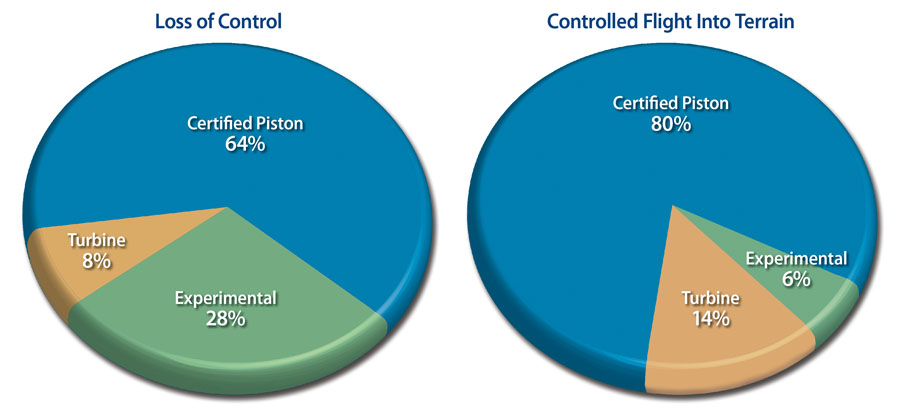
A high percentage of loss-of-control accidents occur in experimental aircraft. Yet pilots of experimentals do a much better job of avoiding controlled flight into terrain.
Loss of Control
Numbers are hard to improve upon unless we understand what causes accidents, and therein lies some interesting data. When all of the accidents are broken down by type, there is one category that stands out above all others: loss of control. As you can see by the chart, the experimental portion of these accidents is quite large.
Now take a look at the chart showing controlled flight into terrain. Here you’ll notice that the percentage of experimental accidents is a markedly smaller part of the total. The thinking is that the reduction is due to all of the extra technology we have in our amateur-built aircraft, such as moving maps. Seems like a good case to be made for getting more of this stuff into certified aircraft cockpits.
So why is it that experimental aircraft are such a high percentage of the loss of control accidents? Could it be that this very same technology is causing distractions at the most inopportune time in the cockpit, perhaps when our attention should be focused outside instead of inside? I know I have seen this, especially when I have participated on first flights as part of the Additional Pilot Program. I bet many of you have experienced this as well. If the engine parameters, such as CHTs or EGTs, aren’t configured properly, you are very likely to get a warning, just about the time the new airplane, with its new engine and new-to-the-aircraft pilot, is in the first climb and has passed the end of the runway. The stress factor is already high, and it’s a normal human reaction to react to horns and other warnings. Many times I have had to remind pilots to keep their head out the window and fly the airplane, while I take care of the cockpit distractions. Engine parameters on first flights with new engines aren’t anything like normal once it’s broken in, and if the limits have been set for normal, well, there’s a big distraction when we least need it.
Other loss-of-control incidents have to do with sharp pull-ups, sometimes known as showboating. It seems that this one will be with us no matter how much preaching we do. The unfortunate thing is that the very same aircraft that tend to bring out the showboat mentality in a pilot typically have enough power and speed to put the pilot in a situation at the top of that pull-up that they have never seen before. It can be very disorienting. Sometimes they get away with it for so long that they become more brazen about it. Then just one thing changes—a heavier load of fuel, higher density altitude, a heavier passenger, a heavy foot on the rudder as it breaks into a stall, you name it. Gravity wins. It always does.
All of us tend to believe it is going to happen to the other pilot. Tell me one of you doesn’t believe that. The reality is that if you believe it could happen to you, then you can take steps to reduce the risk. So accepting that axiom is a great way to at least be ready for it when the situation is presented to you. Work toward stacking the odds in your favor. Accept that you aren’t always young and invincible.
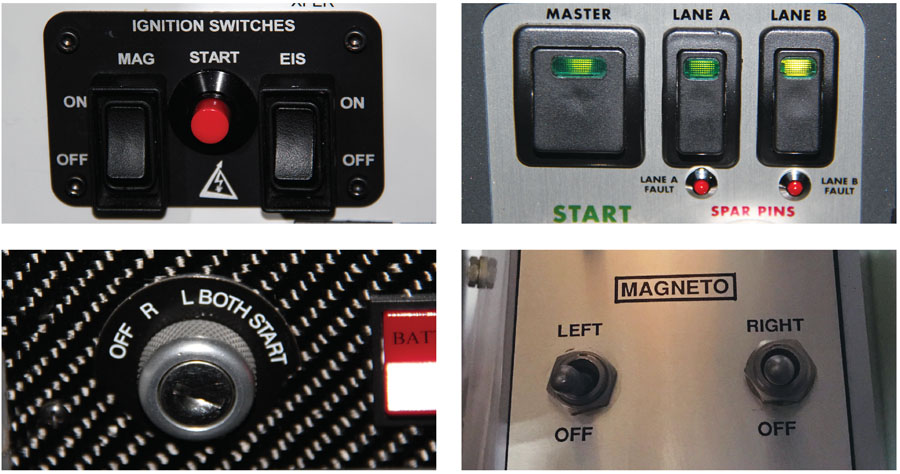
How is the spark controlled in these airplanes? (Top Row) The RV-10 has electronic ignition and a magneto. The RV-12iS has two toggles labeled Lane A and Lane B. (Bottom Row) The RV-14 has a key switch with two magnetos, and the Stearman has two mags controlled by toggle switches. Each plane has different starting procedures requiring one or both ignitions to be on during an engine start.
What’s This Button Do?
Sometimes during the course of the same week, I will fly four or five different airplanes—my own RV-10 and Stearman, Van’s RV-12iS and RV-14, and my neighbor’s L-19 Bird Dog, from which I tow him and his glider. Every one of them is different in almost every way possible. Each of the RVs has a totally different avionics package. The autopilots work differently as well. Fuel systems are unique across all of them. The RV-10 has tip tanks that need to be managed, and the RV-12iS only has an on/off selector for fuel. The -12iS has two electric fuel pumps that need to be on all the time since there is no engine-driven pump, while the -10 and -14 have electric fuel pumps that if not used properly can cause problems, especially on hot starts. The Bird Dog and Stearman have carb heat, the -10 and -14 have alternate air controls, and the -12iS has neither.
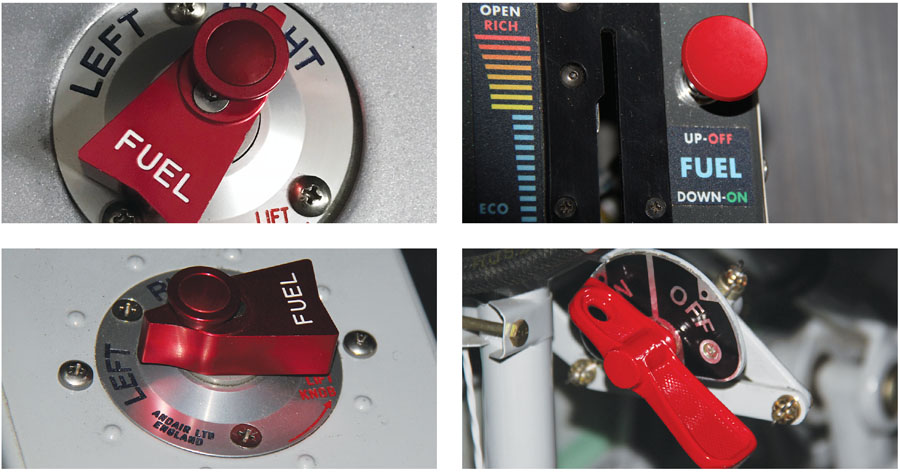
(Clockwise, beginning at upper left) RV-10, RV-12iS, Stearman, and RV-14 fuel valves. Except for the RV-10 and RV-14, the fuel selectors are totally different, require different actuation, and are located in different locations in the various cockpits.
There are lots of other differences, like various buttons on sticks that are in different locations. On one airplane a button might be for PTT, while the same button might disconnect the autopilot on another. I really don’t want to confuse this at the wrong time. Some have electronic ignition and some don’t. Some require starting on only one ignition versus both, or kickbacks and damage can occur.
So what I do when I hop into each one is just sit for a minute and refresh myself on the differences. I always remind myself that the worst possible failure in a single-engine aircraft is an engine failure when we are least expecting it. Whoever really expects it, except in training? I have always drummed into my head and my students that it takes three things to keep the engine running—air, fuel, and spark. So, if there is a problem, I want to know exactly where those three important controls are and what is the correct action. As an example, I know turning on the fuel pump in the -10 should not cause a problem, and it is an immediate course of action if the engine should falter, especially at high power settings. My RV-10 has a Lycoming engine in it. On certain Continental engines, such as in a Bonanza, turning on the fuel pump at the wrong time could actually flood the engine and exacerbate the problem. Yes, at one time I was flying the RV and a Bonanza at the same time and had to remind myself of the correct procedure every time I got in each plane.
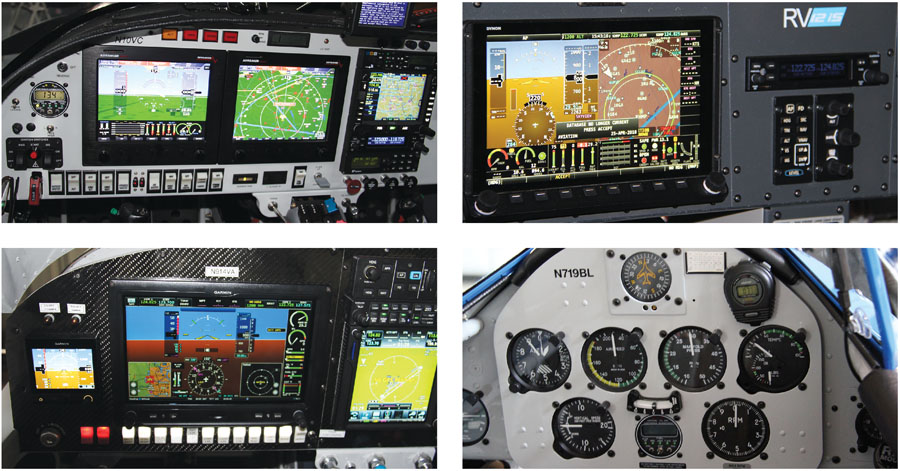
(Clockwise, beginning at upper left) RV-10, RV-12iS, Stearman, and RV-14 panels. The EFISes are different, with different manufacturers for the GPS navigators as well. Internal GPS navigation is used on the RV-12iS. Sometimes it’s just the simple things, like entering a BARO setting on a cross country, that can be totally different across the systems. Of course, the Stearman uses traditional instrumentation.
Carb heat application is usually much different than alternate air. If carb icing really is present, the initial application of carb heat may actually cause the engine to run rougher for a bit until the ice is melted. A normal reaction would be to remove carb heat, thus sealing the fate of the engine. On the other hand, the application of alternate air usually provides immediate results if the problem is due to a clogged intake. Know what to expect.

It is important to understand how the autopilot works and what to expect when various functions are enabled. As you can see, each of these is different. The RV-14 (left) has a YD (Yaw Damper) button. The RV-14 and RV-12iS (center) both have a LEVEL button. The Sorcerer (right) in the RV-10 has the same function, but it is on the integrated display in the EFIS. There is no autopilot in the Stearman.
Unfortunately, there aren’t a lot of standards across the various manufacturers of avionics. Heck, even in cars I am reminded of this every time I pick up a rental car at night in the rain. Why can’t they all put the lights and wiper controls in the same place? Autopilots seem to be the same. For many years the mainstay of autopilots in the experimental world were from TruTrak. When coupled with most of the popular EFISes out there, they will immediately begin a climb or descent based upon the rate of climb or descent displayed on the EFIS. Not so with Garmin or some of the other integrated autopilots. They have configured the autopilot so that you must enter the rate after you enter the altitude, much like in the airliner and corporate worlds. I don’t know if one way is right or wrong, but I will admit that more than once I have sat there wondering why the aircraft isn’t descending or climbing after I entered the altitude change directed by ATC!
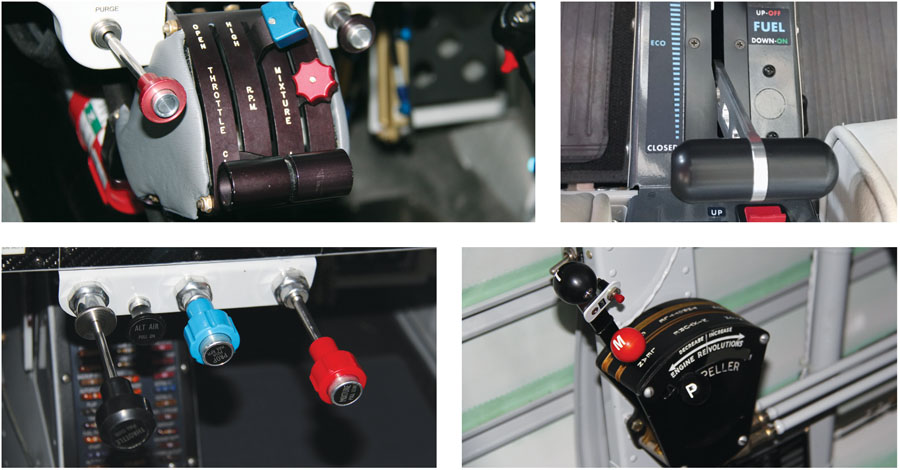
(Clockwise, beginning at upper left) RV-10, RV-12iS, Stearman, and RV-14 throttles. The RV-12iS is a single-lever operation, the others are stock for a constant-speed operation. But wait—notice the Stearman prop lever is all the way back on the ground? The Jacobs R-755 engine requires starting with the counterweighted propeller in the aft position, so it doesn’t rob the engine of oil pressure during startup.
So while I think transition training is really important, and the data seems to back this up, I think everyone should take a few minutes whenever they enter a cockpit and just sit there, reviewing everything for a bit before they start flipping switches. At least ask yourself if you understand what controls the air, fuel, and spark. If it’s been a while since you have flown, the short refresher could make a difference. If you’ve been flying a different airplane, then by all means take the time to understand the differences.
The differences don’t matter until they matter, and then they could really matter. Or as I have always been fond of telling my kids, when you least expect it—expect it. No sense scaring ourselves when we are supposed to be having fun.
Vic Syracuse is a Commercial Pilot, CFII with ASMEL/ASES ratings, an A&P/IA, DAR, and EAA Technical Advisor and Flight Counselor. Passionately involved in aviation for over 40 years, he has built 11 aircraft and logged over 8700 hours in 72 different kinds of aircraft. Vic volunteers as a Young Eagle pilot and Angel Flight pilot. He chairs the EAA Homebuilt Council and is a member of EAA’s Board of Directors. He also has his own sport aviation business called Base Leg Aviation.











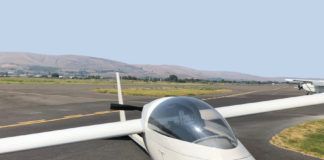
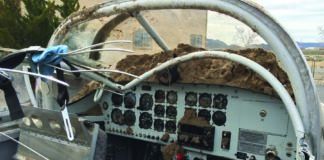
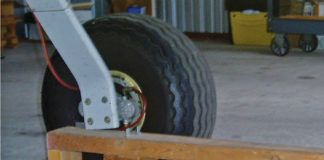
This is an interesting article, but I don’t think I fully understand the underlying data, which is given as fraction of the fleet per kind of accident. This obscures so much information. It would be very informative to have it represented as kind of accidents per hours flown in experimentals vs certified, kind of accidents relative to training and experience in experimentals vs certified etc etc. Are pilots flying experimentals, on average, trained to a lesser degree or less experienced than pilots flying certified aircraft? Are the LOC accidents really due to distraction by cockpit instruments, or is there another cause? Is the low proportion of experimentals involved in CFIT accidents actually due to the fact that these airplanes are usually flown for recreation, and that most of this flying happens in VMC, where CFIT is unlikely?